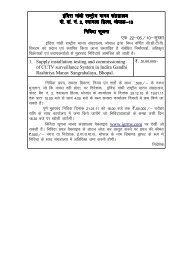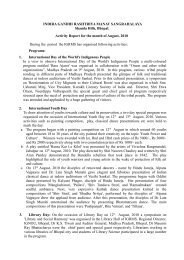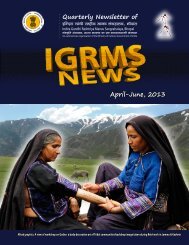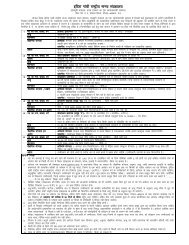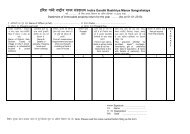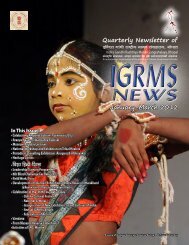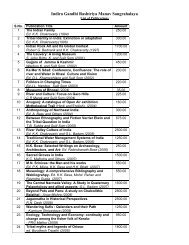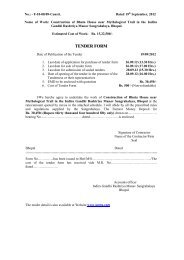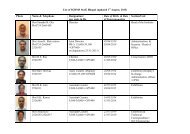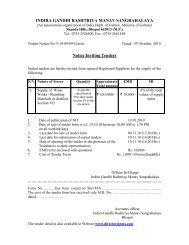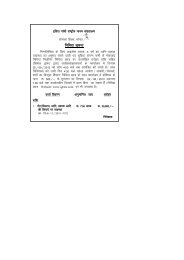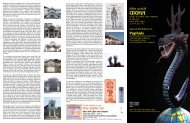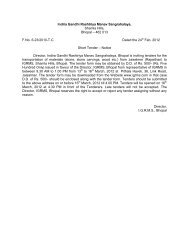Indira Gandhi Rashtriya Manav Sangrahalaya (National ... - IGRMS
Indira Gandhi Rashtriya Manav Sangrahalaya (National ... - IGRMS
Indira Gandhi Rashtriya Manav Sangrahalaya (National ... - IGRMS
You also want an ePaper? Increase the reach of your titles
YUMPU automatically turns print PDFs into web optimized ePapers that Google loves.
<strong>Indira</strong> <strong>Gandhi</strong> <strong>Rashtriya</strong> <strong>Manav</strong> <strong>Sangrahalaya</strong> 285<br />
Gallery 8 : Masks–Varieties of traditional masks collected from different parts<br />
of India are displayed.<br />
Gallery 9 : Textile & Culinary Traditions–traditional architecture, textile tradition,<br />
traditional technology and culinary traditions are displayed.<br />
Gallery 10 : Reserve Collection & Research Gallery–A representative collection of<br />
about 4,000 objects from the Museum’s artifacts store of over 20,000<br />
objects (till 2008) are on display in a big hall on the lower ground<br />
floor. This is one of the few museums where a significant number<br />
of specimens from reserve collections is on display for informed<br />
visitors.<br />
An important aspect of these galleries are the active involvement of different<br />
community groups from different parts of the country in developing the exhibits,<br />
and its presentation in appropriate environment. Another special feature is the<br />
life size displays and visitor friendly approaches for visitors’ convenience.<br />
Museum Education and Salvage Activities<br />
The Museum began to organise different kinds of education programmes since<br />
1985 onwards. Different Museum Education activities were designed to develop<br />
programme packages. These are in the form Travelling Exhibitions on different<br />
themes of traditional art and community knowledge systems; organizing ‘Do and<br />
Learn’ participatory training Programme for interested persons on various<br />
traditional art forms; Organising Seminars/ Camps and Workshops to disseminate<br />
information on bio-cultural evolution of mankind and celebrate the cultural<br />
diverisities and national integration.<br />
The first Travelling Exhibition-Yatra (The Journey of mankind) began its<br />
journey to Delhi in January, 1986, as part of the annual meet of the 73rd Session<br />
of Indian Science Congress. This exhibition was an attempt to present, in a<br />
miniature form, the bio-cultural evolution of mankind and the patterns of<br />
contemporary cultures in India in the form of a living-museum display. For<br />
example, a model of an Agaria hut was built and a few Agaria artisans from the<br />
remote Bastar area of Madhya Pradesh were invited to demonstrate their traditional<br />
skill of iron smelting practice. Science Congress specialists interacted with these<br />
tribal artisans and appreciated their technology.<br />
Construction of an exhibition-structure-Avritti Bhawan–for organizing<br />
periodical exhibitions was completed by early 1990, and the first periodical<br />
exhibition Vastu Prasang started at Shamla Hills in May 1990. The <strong>IGRMS</strong> hosted<br />
a series of periodical exhibitions, and national seminars in Bhopal.<br />
Paradigm Shift: Primacy to Communities and Museum as a Facilitator<br />
The structure and functions of the Museum began to take definite shape after it<br />
became an autonomous organization in the year 1985. Sachin Roy had envisaged



